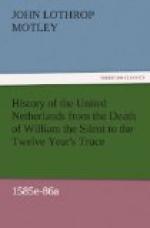Meantime Sir Thomas Heneage was despatched on his mission to the Staten, despite all the arguments and expostulations of Walsingham, Burghley, Hatton, and Davison. All the Queen’s counsellors were unequivocally in favour of sustaining Leicester; and Heneage was not a little embarrassed as to the proper method of conducting the affair. Everything, in truth, was in a most confused condition. He hardly understood to what power he was accredited. “Heneage writes even now unto me,” said Walsingham to Davison, “that he cannot yet receive any information who be the States, which he thinketh will be a great maimer unto him in his negotiation. I have told him that it is an assembly much like that of our burgesses that represent the State, and that my Lord of Leicester may cause some of them to meet together, unto whom he may deliver his letters and messages.” Thus the new envoy was to request the culprit to summon the very assembly by which his downfall and disgrace were to be solemnized, as formally as had been so recently his elevation to the height of power. The prospect was not an agreeable one, and the less so because of his general want of familiarity with the constitutional forms of the country he was about to visit. Davison accordingly, at the request of Sir Francis, furnished Heneage with much valuable information and advice upon the subject.
Thus provided with information, forewarned of danger, furnished with a double set of letters from the Queen to the States—the first expressed in language of extreme exasperation, the others couched in almost affectionate terms—and laden with messages brimfull of wrathful denunciation from her Majesty to one who was notoriously her Majesty’s dearly-beloved, Sir Thomas Heneage set forth on his mission. These were perilous times for the Davisons and the Heneages, when even Leicesters and Burghleys were scarcely secure.
Meantime the fair weather at court could not be depended upon from one day to another, and the clouds were perpetually returning after the rain.
“Since my second and third day’s audience,” said Davison, “the storms I met with at my arrival have overblown and abated daily. On Saturday again she fell into some new heat, which lasted not long. This day I was myself at the court, and found her in reasonable good terms, though she will not yet seem satisfied to me either with the matter or manner of your proceeding, notwithstanding all the labour I have taken in that behalf. Yet I find not her Majesty altogether so sharp as some men look, though her favour has outwardly cooled in respect both of this action and of our plain proceeding with her here in defence thereof.”
The poor Countess—whose imaginary exodus, with the long procession of coaches and side-saddles, had excited so much ire—found herself in a most distressing position. “I have not seen my Lady these ten or twelve days,” said Davison. “To-morrow I hope to do my duty towards her. I found her greatly troubled with tempestuous news she received from court, but somewhat comforted when she understood how I had proceeded with her Majesty . . . . But these passions overblown, I hope her Majesty will have a gracious regard both towards myself and the cause.”




